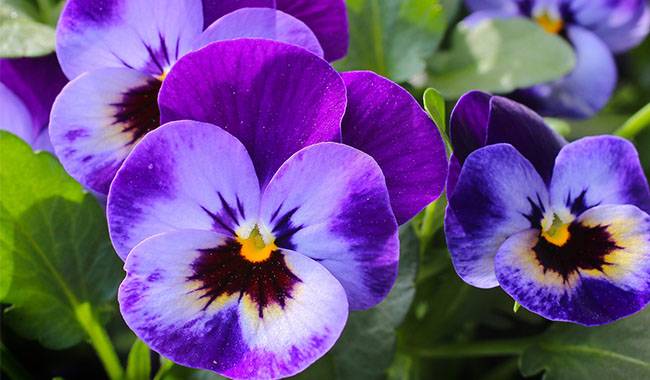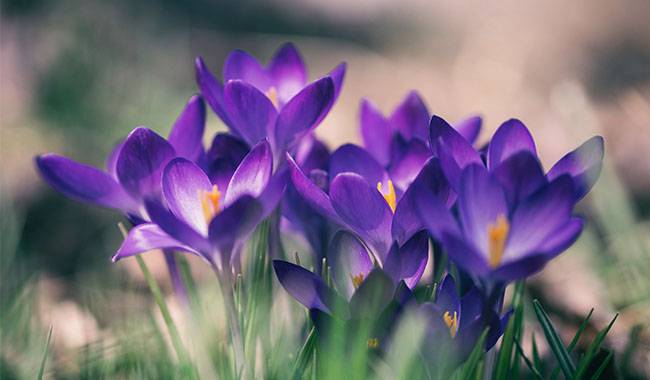
The name Violet has become so closely associated with the delicate and moving Cyclamen that the true representative of the Violet family is often forgotten in the room. But not the most adaptable to potted forms and living spaces, attractive pansies can also adorn summer windowsills and balconies. They are not long-lived and require attention, but they are easy to propagate. And it’s hard to find equally moving, colorful treasures among the small, colorful blooming plants. Violet has so many options that you can find the right violet for any home. You will learn how to grow plants in the ThumbGarden article.
WHICH GARDEN CAN VIOLETS BE GROWN INDOORS?
Violet’s foliage gathers in rosettes at the roots, sitting alternately on stems, with bright oval leaves decorated with beautiful crenelated edges that are barely visible beneath the flowers. They are solitary for such a small bush but bloom in surprisingly large numbers, and they have larger lower petals decorated with interesting marigold-like outgrowths at the base that look irresistible.
Violet flowers range from 2-4 inches (5-10 cm) in diameter and attract attention with their bright yellow eyes, velvety petal texture, unique and easily recognizable asymmetry, and inimitable variety of petal shapes.
As a potted plant to decorate a room or balcony, only a few varieties of Garden Violet are used, most often without distinguishing the differences between the pansies.
Viola x wittrockiana;
Viola tricolor.
They are represented by numerous hybrids revered for their delightful variety of flowers.
Garden Violet flower has been considered a versatile plant suitable even for novice gardeners. But for potted Violets, their status as an unpretentious plant is less important. And in turning to the container format, it’s worth first considering the few but obvious drawbacks. It is no coincidence that this garden plant has never been the star of greenhouses and interior design.
DISADVANTAGES OF POTTED VIOLET PLANTS
Violet is not the most adapted plant for the potted balcony format and needs to be given certain conditions at home and on the balcony. Only a few placement options are suitable for them. And before deciding to consider it as more than just a garden plant, it is worth weighing all possible risks. Making the viola bloom relentlessly and look fresh still needs special attention.
Daily care is the first thing to consider. Even in the garden, lack of moisture means you have to look at bushes with lush blooms rather than sluggish, lifeless plants. However, in the open air and flower beds, failure to water can be fatal on a windowsill or balcony.
Even brief droughts can affect foliage, and you should water only when the surface of the substrate is slightly dry – avoiding wetness and standing water, but not too little moisture either. In the summer, Violet needs to be watered twice a day, only in the early morning or late afternoon. And without an automatic irrigation system, this drawback is difficult to compensate for.
It is also not easy to satisfy Violet’s love for fresh air. Even on glass balconies, their poor flowering suffers, while on windowsills, they need special treatment altogether. Nothing will work without constantly open windows, fresh ventilation, and free air circulation. This does not mean that it is impossible to grow Violet on a windowsill. You can. But follow all the recommendations as strictly as possible in a half-open window.
Violet on the balcony is only for those who can provide regular care for it. If you have travel plans or are away and don’t have someone to look after the plants daily, it’s best to rule them out as a candidate for balcony gardening.
THE MAIN ADVANTAGES OF VIOLET ON THE BALCONY AND IN THE ROOM

But all the disadvantages pale in front of the extraordinary beauty and vibrant flowers of Violet in the garden. Even Violet that has been moved to the balcony, is still charming. And it isn’t easy to find a florist who still cares for them.
The main advantages of Violet as a balcony plant include
Colorful flowers
Few other plants can compete with Viola because of its beautiful asymmetrical flowers, size, and range of colors. With its tiny “eyes” and lovely veining, its watercolor transitions, combinations of dozens of shades, or the most dazzling colors, Violet always looks striking. For some, Violet flowers are reminiscent of butterflies. For others, magical figures, funny faces, and curious little elves. But it’s hard not to be captivated by their beauty.
Vibrant bouquets for viewing
Even a single Violet plant in a miniature pot looks like a little miracle. They look like bouquets freshly picked from the garden when planted in groups. The large flowers, neat foliage, dense flower mats, miniature size, and versatility make this plant a touching little addition to the tabletop, an alternative to cut flowers or a gift. And they are perfect for growing in decorative containers and experimenting with decoration (with sisal, fabric, decorative mulch, etc.).
Violet Varieties are Vast
The number of Violet varieties is almost impossible to count. Even tried-and-true seed mixes always produce plants with unexpected color variations. And it seems rather complicated to choose Violet that is monochromatic or multicolored, mottled or squared, simple or terry, small or large-flowered. If Violet’s palette is small, they also offer a choice between compact and spreading, shrubby, and appeals forms!
Compatibility with other plants
Violet can easily be added to indoor and balcony plants, used in groups with beautiful flowering and deciduous partners, planted in complex ensembles and layered arrangements. However, keep in mind that they will not tolerate too crowded a planting environment. Large varieties require 4-6 inches (10-15 cm) of space in a group or 35-70 cubic feet (1-2 cubic meters) of soil.
Ability to grow in miniature and virgin containers
Violet can be grown in almost any container, even the most extravagant, as long as you can think of drainage to prevent the risk of the soil becoming acidic when watered too much. Violets are often grown in bowls and teapots, watering cans, cups and glasses, interesting containers, and fun ceramic designs.
They look great in boxes, hanging baskets, pots, stemmed vases, and plain pots made of any material, as long as the size of the container does not exceed the size of the plant or the root system of the Violet colony. They do not like too much “space,” and the container should match the plant.
Easy to propagate
Violet is easy to grow from seed, especially since it is one of the most popular garden annuals and biennials. Sow in shallow trenches in February, or lightly cover the soil and keep it around 59 °F (15°C) after lightly moistening under glass or film. Cool and bright light is a Violet seedling’s best friend. Propagation is not complete until the first few leaves appear, and seedlings can be placed in permanent pots after 2-3 weeks.
However, it is much easier to purchase ready-made seedlings. You can only compare the popularity of violas with petunias. When the weather warms up, young plants that can be bought to your liking fill all the stalls and flea markets and don’t disappear throughout the summer.
REQUIREMENTS AND CARE FOR INDOOR VIOLET PLANTS

To successfully grow indoor Violet on a balcony and even more on a windowsill, you need extra care and special conditions.
- bright diffused light as possible (Violet is not afraid of direct sunlight, but not at midday, not on a southern balcony, and not in high summer when strong shade is harmful without at least a few hours of morning or evening sun; Violet grows best on western and eastern balconies, in rooms – with a screen on a southern window)
- temperatures of 50-77 °F (10-25°C), with as little chilling as possible, and protection from high temperatures
- regular watering without fail and stable average humidity.
- weekly fertilization (from the second week after planting) with special fertilizers for Violet, summer plants, or at least nice flowering plants
- Layout a very high drainage system – even for miniature containers – 1 inch (2.5 cm).
- choose loose, permeable, and very nutritious soil.
- Loosen the soil regularly (preferably once a week).
- Prune the flowering parts at regular intervals, promptly cutting off half of the shoots that have lost their decorative and dryness to stimulate growth and second flowering – to a height of 2 inches (5 cm), leaving a few leaves on each shoot.
Another advantage should not be forgotten. Even when in bloom, they are easy to replace, and there is no need to worry about replanting, so you can replace Violets that have lost their decorative qualities with new young shrubs. If a variety is disappointing and the Violet has lost its ornamental qualities due to failure of care, you can easily plant new flowering plants to replace them.







